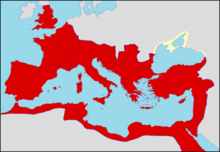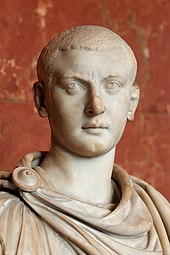Gordian dynasty
| Gordian Dynasty | |||
|---|---|---|---|
| 238–244 | |||
 The reign of Gordian I was very brief. | |||
| Monarch(s) | |||
Chronology
| |||
| Part of a series on Roman imperial dynasties |
| Year of the Six Emperors |
|---|
| AD 238 |
|
The Gordian dynasty, sometimes known as the Gordianic dynasty, was a short-lived dynasty which ruled the Roman Empire from 238–244 AD. The dynasty first achieved the throne in 238 AD, after Gordian I and his son Gordian II rose up against Emperor Maximinus Thrax, and were proclaimed co-emperors by the Roman Senate. Gordian II was killed by the governor of Numidia, Capillianus, and Gordian I killed himself shortly after, either 21 or 36 days after he was declared emperor. On 22 April 238 Pupienus and Balbinus, who were not of the Gordian dynasty, were declared co-emperors, but the Roman Senate was forced to make Gordian III a third co-emperor on 27 May 238 due to the demands of the Roman people. Maximinus attempted to invade Italy, but he was killed by his own soldiers when his army became frustrated. After this, the Praetorian Guard killed Pupienus and Balbinus, leaving Gordian III as the sole emperor. Gordian III ruled until 244 AD, when he was either killed as a result of betrayal by Philip the Arab, killed directly by Philip the Arab, or killed at the Battle of Misiche. With him died the Gordian dynasty, and after his death Philip the Arab rose to become emperor.
History

The Gordian dynasty rose in opposition to Maximinus Thrax, who had been proclaimed Emperor by the army, but not the senate, and whose reign, lasting from 235–238 AD, was characterized by tyranny and brutality. Maximinus embezzled from the public treasury and expropriated taxes collected by cities. He reversed the religious reforms of Emperor Severus Alexander, which had increased tolerance toward Christianity. During his reign, the popes Pontian and Anterus were put to death, along with the antipope Hippolytus. There was a vast amount of corruption during his rule, with his favored officials prosecuting individuals on false charges and extorting huge fines.[1] His abuses towards the population led to an uprising in the province of Africa in 238, where the people revolted and killed his tax collectors. The movement gathered momentum rapidly, especially among the army, who proclaimed the governor of Roman Africa, Gordian I, the emperor.[2]

A delegation of centurions was sent to Rome from Africa, firstly to assassinate Publius Aelius Vitalianus, the Praetorian prefect, and secondly to spread a rumor that Maximinus had been killed while campaigning against the Sarmatians. The Roman Senate believed the rumor, and proclaimed Gordian I and his son Gordian II as co-emperors in 238. In the same year, Capillianus, governor of Numidia, invaded Africa and succeeded in killing Gordian II during the Battle of Carthage. Gordian I shortly thereafter hanged himself out of grief, either 21 or 36 days after being declared emperor. Following the news of both emperors' deaths, the Roman Senate formed a committee of twenty senators to elect the next emperor, resulting in the election of two of the senators on the committee, Pupienus and Balbinus, on 22 April 238.[2][3][4] However, large crowds gathered in Rome, demanding that a blood relative of Gordian I also be made emperor. The Senate acceded, and elected Gordian III, the son of Gordian I's daughter Antonia Gordiana, as third emperor on 27 May 238.[2] It was at this point that the news of the Gordians' rebellion reached Maximinus, who was still campaigning against the Sarmatians in Pannonia. He took his Pannonian Legions and immediately marched to Italy. He attempted to gain the allegiance of the fortified city of Aquileia, but when that failed, he laid siege to it.[2] His troops became disaffected during the unexpected siege, at which time they suffered from famine and disease. In May 238, Maximinus' soldiers rose up and killed him, along with his son, Maximus.[5][6] Shortly thereafter, on 29 July 238, Pupienus and Balbinus were also killed by the Praetorian Guard, who proclaimed Gordian III sole emperor.[7][8]
When the Sassanids invaded the Roman Empire in 241, occupying the province of Syria and capturing Antioch and Carrhae, Gordian III sent Timesitheus to counterattack. He successfully recaptured the cities and won a decisive victory at Battle of Resaena. However, between 242 and 243, while leading troops across the Euphrates, Timesitheus fell ill and died from what is believed to have been an intestinal infection.[9] Shortly after this, in 244, Gordian III also died, although the manner of his death is a matter of debate. There is evidence that Philip the Arab, who had been deputy Praetorian prefect, and who rose to the title of Praetorian prefect after the death of Timesitheus, actively undermined Gordian III's authority.[10] Zosimus and the Historia Augusta said that Philip the Arab conspired to have him killed by intentionally introducing deficiencies in supplies, so as to turn the army against him. Orosius, Festus, John of Antioch and Eutropius assert that Philip the Arab played a more direct role in having him killed, beginning to conspire after Gordian III won a great victory in Persia. George Syncellus and the Epitome de Caesaribus say that Philip began planning to betray him before the army had reached Ctesiphon, and not after a great victory.[10] Byzantine and Persian sources, Zonaras and Cedrenus, and the Persian King Shapur I, wrote that Gordian III died in the Battle of Misiche.[10] Philip the Arab claimed the throne for himself after Gordian III died.[7][11]
Numismatics

During the reign of Gordian III multiple changes took place in Roman numismatics. The Tetradrachm, a coin equivalent to four drachma, was produced again, having not been minted since the reign of Elagabalus, between 218–222, during which only two mints produced it, and not having been widely minted since the reign of Macrinus, between 217–218. The production of Tetradrachms continued after Gordian's death, being widely produced until 253, when the last Tetradrachm was minted.[12] The Antoninianus, equivalent to 20 Assēs, which had been abandoned during the reign of Elagabalus, was brought back and rapidly replaced the denarius, which was equivalent to 10 Assēs. After 240, apart from two large issues struck under Gordian, the denarius was only produced on a small local scale until it was later brought back by Aurelian in 270.[13][14]
During the reign of Gordian III, the issue of the lack of uniformity in coin weight and quality became severe, with eastern mints consistently creating heavier and purer coins. For example, the Antoninianus' minted in Antioch had an average silver fineness of 43.5%, whereas those of Rome had only an average silver fineness of 36.8%. Because both coins were of similar average weight, this meant that the Antiochian coins were 15% purer than those of Rome.[15] Antioch became an increasingly important mint under Gordian, striking even gold coins, something previously only mints in the capital of Rome did on a large scale.[16] During the reign of Gordian, provincial silver coins, produced from the important mints of Antioch, Caesaria, and Alexandria, increasingly came to be used by the state for funding, becoming roughly equal in use to that of the antoninianus.[17]
Throughout the reign of Gordian III, coins were used to establish Gordian III's legitimacy and his fitness to rule. During the early reign, a large number of coins declaring the Virtus (virtue) of Gordian III were minted, but later coins bearing such a description ceased to be minted. The reason for this is likely that Gordian III, who was very young and had never had any military position, was attempting to establish his virtus to the army in order to compensate for his lack of experience.[18] Late in his reign, coins depicted Gordian holding a Victoriola, a statue which represents victory, thereby declaring himself to possess 'victory' itself.[19]
Politics
During the Gordian dynasty several reforms were made, mostly in provincial administration, fiscal policy, and the army. Under Gordian III, reforms were made to limit frivolous lawsuits. Focus was also placed on strengthening the defences of the Roman frontiers and punishing any abuses of power in the provinces. Despite the efforts of the dynasty, this period was marked by political and economic difficulty. Much of the state affairs during the late years of Gordian III were controlled by his wife, Tranquillina.[20] Gordian enacted a rescript that removed the four year statute of limitation on seeking restitution for soldiers and state officials.[21] Of all the rescripts issued by Gordian, 13% went to soldiers.[22] During his reign, the Roman Empire paid tribute to the Goths systematically, in order to prevent raids.[23]
The Gordian dynasty reversed the policy of the persecution of Christians, which had been put in place by Maximinus, and which was largely focused on the prosecution of bishops and popes. Because Gordian III ended all persecution of Christians during his reign, Eusebius claims that Gordian III himself became Christian and served penance for the sins of Maximinus.[24]
References
Citations
- ^ Laale 2011, p. 272.
- ^ a b c d Laale 2011, p. 273.
- ^ Hekster 2008, p. 14.
- ^ Pearson 2016, p. 135.
- ^ Bunson 2014, p. 360.
- ^ Laale 2011, pp. 273–274.
- ^ a b Laale 2011, p. 274.
- ^ Adkins & Adkins 2014, p. 27.
- ^ Hekster 2008, p. 19.
- ^ a b c Hebblewhite 2016, p. 28.
- ^ Brent 2009, p. 51.
- ^ Metcalf 2016, p. 474.
- ^ Metcalf 2016, p. 516.
- ^ Metcalf 2016, p. 543.
- ^ Metcalf 2016, p. 519.
- ^ Metcalf 2016, p. 526.
- ^ Metcalf 2016, p. 527.
- ^ Hebblewhite 2016, p. 35.
- ^ Hebblewhite 2016, p. 42.
- ^ Lightman & Lightman 2008, p. 201.
- ^ Hebblewhite 2016, p. 123.
- ^ Hebblewhite 2016, p. 122.
- ^ Ando 2012, p. 118.
- ^ Hopkins 2009, p. 181.
Bibliography
- Adkins, Lesley; Adkins, Roy A. (2014). Handbook to Life in Ancient Rome. New York: Facts On File. ISBN 9780816074822.
{{cite book}}: Invalid|ref=harv(help) - Ando, Clifford (2012). Imperial Rome AD 193 to 284: The Critical Century. Edinburgh: Edinburgh University Press. ISBN 9780748655342.
{{cite book}}: Invalid|ref=harv(help) - Brent, Allen (2009). A Political History of Early Christianity. London: T & T Clark. ISBN 9780567606051.
{{cite book}}: Invalid|ref=harv(help) - Bunson, Matthew (2014). Encyclopedia of the Roman Empire. New York: Facts On File. ISBN 9781438110271.
{{cite book}}: Invalid|ref=harv(help) - Hebblewhite, Mark (2016). The Emperor and the Army in the Later Roman Empire, AD 235–395. Abingdon: Taylor & Francis. ISBN 9781317034308.
{{cite book}}: Invalid|ref=harv(help) - Hekster, Olivier (2008). Rome and its Empire, AD 193-284. Edinburgh: Edinburgh University Press. ISBN 9780748629923.
{{cite book}}: Invalid|ref=harv(help) - Hopkins, Richard R. (2009). How Greek Philosophy Corrupted the Christian Concept of God. Cedar Fort: Horizon Pub & Dist Inc. ISBN 9780882907826.
{{cite book}}: Invalid|ref=harv(help) - Laale, Hans Willer (2011). Ephesus (Ephesos): An Abbreviated History From Androclus To Constantine XI. Bloomington, IN: WestBow Press. ISBN 9781449716189.
{{cite book}}: Invalid|ref=harv(help) - Lightman, Marjorie; Lightman, Benjamin (2008). A to Z of Ancient Greek and Roman Women. New York: Facts On File. ISBN 9781438107943.
{{cite book}}: Invalid|ref=harv(help) - Metcalf, William E. (2016). The Oxford Handbook of Greek and Roman Coinage. Oxford: Oxford University Press. ISBN 9780199372188.
{{cite book}}: Invalid|ref=harv(help) - Pearson, Paul N. (2016). Maximinus Thrax: Strongman Emperor of Rome. Pen and Sword. ISBN 9781473847064.
{{cite book}}: Invalid|ref=harv(help)
